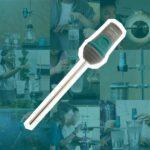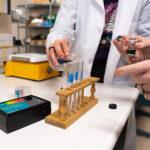
Sharing ideas and inspiration for engagement, inclusion, and excellence in STEM

Whether you teach college chemistry, high school biology, or middle school science, a pH sensor is a great tool to help your students explore the fundamental scientific concept of pH.
But what is the best way to store a pH sensor? How do you calibrate it? And say you unexpectedly find yourself in possession of a pH sensor. How do you know if it even works?
Vernier has answers! I helped develop our pH sensors—and I use them extensively. Over the years, I’ve drawn on these experiences to field a lot of questions from science educators about pH sensor care. Here are answers to five of the most commonly asked questions.
1. What’s the best way to store my pH sensor?
First and foremost, be sure to use the storage solution provided—and be sure to replace it about twice a year. Also, store your pH sensor in its storage bottle three-quarters full of the solution so that it is always submerged, even when lying on its side. It’s a good idea to replace the storage solution before you leave for an extended period (e.g., summer vacation) to help prevent mold growth. If you do see mold in the storage bottle, use a brush and mild detergent to remove it.

2. How do I calibrate my pH sensor?
A calibration equation is stored on each Vernier pH sensor before it is shipped. For the most accurate measurements with your sensor, perform a two- or three-point calibration with two or three different buffer solutions. For best results, the calibration points should be widely separated and bracket the range you anticipate in your experiment. For most chemistry experiments, the buffer solutions typically have a pH of 4, 7, and/or 10.
Before doing a two- or three-point calibration, you must prepare your sensor by removing the storage bottle and rinsing the tip with deionized water. Don’t wipe the sensing tip. Rather, blot it with a lint-free tissue to remove excess moisture—and don’t wipe the sensing glass.
3. If the glass bulb of my pH sensor is broken, can it be repaired?
Unfortunately, no. However, some Vernier pH sensors can be purchased in two parts, so you can replace just the electrode. For instance, the Go Direct® pH BNC Electrode is the replacement electrode for the Go Direct pH Sensor.
Here are some tips to help keep the glass bulb of your pH sensor intact:
- Avoid hitting the edge of the beaker or other vessel with the tip of the electrode.
- Refrain from using the electrode to stir a solution. If you must do so, avoid touching the bottom and sides of the vessel.
- If you are using a stir bar, do not lower the tip of the electrode so far that the stir bar strikes it.
- Never let the glass bulb touch anything other than liquid. For example, if you’re measuring the pH of a stream, don’t let the tip of the sensor touch rocks, sand, or gravel.
4. Why doesn’t my pH sensor read pH 7 in distilled or deionized water?
It boils down to ions—the electrode in your pH sensor won’t give accurate pH values in distilled or deionized water because these liquids do not have enough ions present for the electrode to function properly. Tap water usually does have enough ions, though, which means it can also be a good storage solution for up to 24 hours.
Remember: Any type of water is not “pure” (i.e., has a theoretical pH of 7). The moment water comes into contact with air, carbon dioxide begins dissolving into it, forming carbonic acid, so the actual pH will typically be slightly less than 7.
5. I found an old pH sensor in a supply closet. How do I know if it works?
Start with a calibration check (see question 2). If that fails, follow these three steps to rejuvenate, or shock, your older pH sensor:
- Soak the sensor in 0.5 M hydrochloric acid overnight.
- Rinse the sensor and soak it in fresh storage solution for one hour.
- Calibrate the sensor and store the calibration.
If your pH sensor doesn’t work after you shock it, you may need to replace it and dispose of the old one. But here’s the good news: If your pH sensor comes in two parts, you have to replace only the electrode portion (see question 3). Also, with good care and feeding, a pH sensor can last about five to seven years.
Looking for more pH sensor care tips? Check out this recent webinar: pH Sensor Care and Feeding. In this webinar, Nüsret Hisim and I take a deep dive into pH sensor maintenance and calibration. We also answer questions about Vernier pH sensors (including the cabled and wireless options) from users of LabQuest® and Vernier Graphical Analysis®.
And if you have additional questions about pH sensor care—or Vernier pH sensors—we’re happy to help! Feel free to contact us at chemistry@vernier.com or 888-837-6437.
Share this Article

Sign up for our newsletter
Stay in the loop! Beyond Measure delivers monthly updates on the latest news, ideas, and STEM resources from Vernier.






